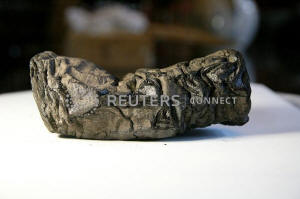|
The
two complete scrolls and four fragments - from the so-called
Herculaneum library, the only one surviving from antiquity -
were buried and carbonized by the deadly eruption of Mount
Vesuvius in 79 AD and are too fragile to be opened.
The items were examined at the Diamond Light Source facility in
Oxfordshire, home to Britain's synchrotron, a particle
accelerator in which beams travel around a closed-loop path to
produce light many times brighter than the sun.
"The idea is essentially like a CT scanner where you would take
an image of a person, a three-dimensional image of a person and
you can slice through it to see the different organs," said
Laurent Chapon, physical science director of Diamond Light
Source.
"We... shine very intense light through (the scroll) and then
detect on the other side a number of two-dimensional images.
From that we reconstruct a three-dimensional volume of the
object... to actually read the text in a non-destructive
manner," Chapon said.
The ink on the scrolls is difficult to see, even through a
synchrotron, because it is carbon-based like the papyrus it is
written on. But scientists hope the density of the paper will be
different where written characters are present.
By scanning the fragments where characters are visible, they
hope to create a machine-learning algorithm that will decipher
what is written on the scrolls.
The data generated by the process will be analyzed by scientists
at Kentucky University in the United States using advanced
computing techniques to decipher the scrolls' contents.
"The library at Herculaneum was the only library that survived
from antiquity and because of that the material inside is
extremely valuable," said Brent Seales, professor of computer
science at Kentucky University.
"Texts from the ancient world are rare and precious, and they
simply cannot be revealed through any other known process."
(Reporting by George Sargent; Writing by Gareth Jones; Editing
by Mike Collett-White)
[© 2019 Thomson Reuters. All rights
reserved.] Copyright 2019 Reuters. All rights reserved. This material may not be published,
broadcast, rewritten or redistributed.
Thompson Reuters is solely responsible for this content.

|
|






